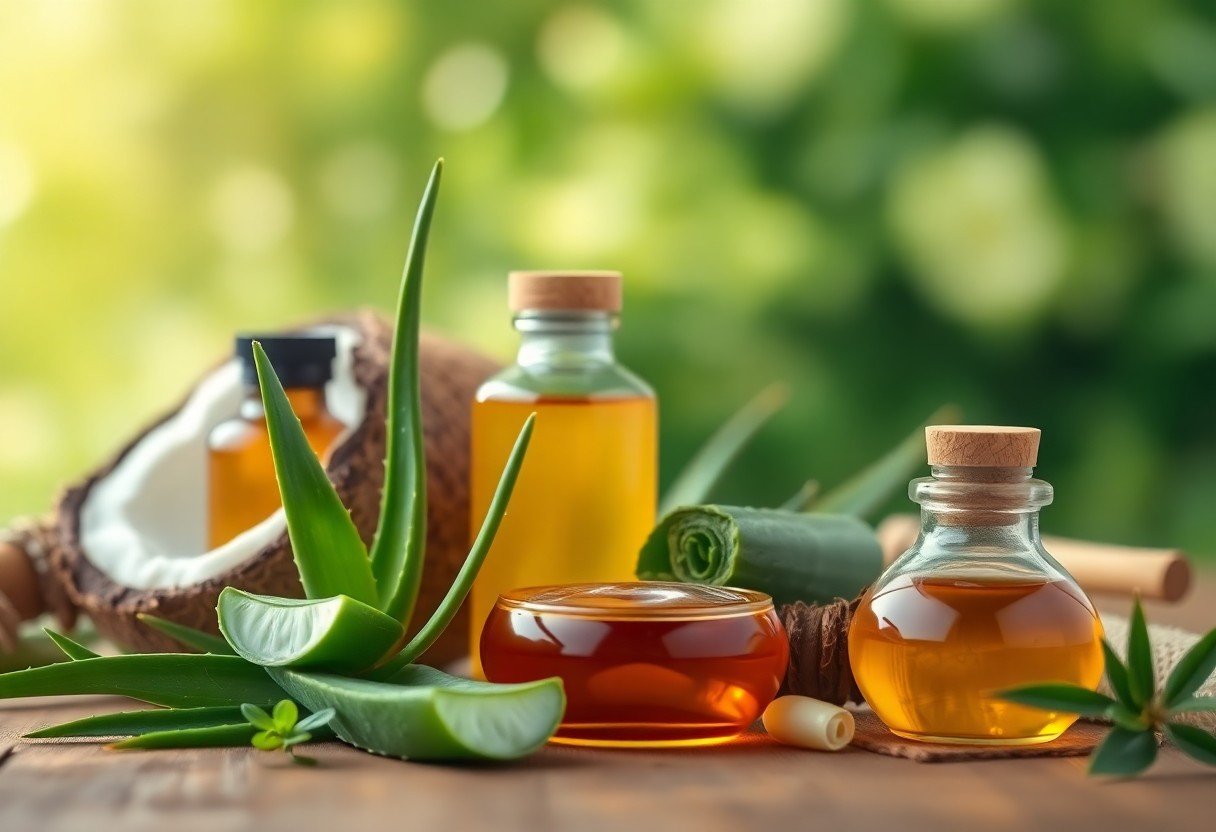Treating rough patches and dry spots on your skin can be a straightforward process with the right knowledge and natural remedies. By incorporating gentle exfoliation, hydrating oils, and soothing masks into your routine, you can restore your skin’s natural texture and moisture balance. In this guide on how to Achieve Silky Smooth Skin Naturally, you’ll discover various techniques and ingredients that not only promote healing but also enhance the overall appearance of your skin. Embrace these natural methods to see significant improvements and achieve a healthier, more radiant complexion.
Table of Contents

How To Achieve Silky Smooth Skin Naturally?
Key Takeaways:
- Natural Oils: Incorporate oils like coconut, olive, or jojoba in your routine to nourish and hydrate dry skin. Check out our recommendations in Top Natural Oils for Skincare.
- Exfoliation: Use natural scrubs made from sugar or oatmeal to gently remove dead skin cells and promote smoothness. Learn more in our article on Best Natural Exfoliants.
- Hydrating Masks: Apply homemade masks with ingredients like honey and avocado to deeply moisturize rough patches. For DIY ideas, refer to Homemade Masks for Hydration.
- Stay Hydrated: Drink plenty of water and include hydrating foods in your diet to support skin health from the inside out.
- Avoid Harsh Products: Select gentle, natural skincare products that are free from alcohol and synthetic chemicals to prevent further irritation.

Types of Rough Patches and Dry Spots
While navigating skin issues, you may encounter various types of rough patches and dry spots. Here’s a breakdown of some of the most common types you might experience. For each, consider our specific Skin Solutions Guide to target your needs:
| Type | Description |
| Dry Skin | Flaky and often itchy skin that feels tight. |
| Eczema | Inflamed, red patches that may ooze or crust over. |
| Psoriasis | Thickened, scaly areas that can be silver in color. |
| Keratosis Pilaris | Small, red or white bumps often found on the arms and thighs. |
| Fungal Infections | Red, itchy patches that may become more inflamed with moisture. |
Each of these conditions presents unique challenges and symptoms, making it necessary to understand their distinctions. If you notice persistent areas affecting your skin quality or comfort, seeking further information or professional advice can be beneficial.
Common Causes
Several environmental and lifestyle factors contribute to these skin issues, including:
- Climate changes: Adjust your routine to include protective moisturizers and hydration boosters during dry seasons. For tips on adapting, read Seasonal Skincare Adjustments.
- Harsh soaps: Choose gentle, pH-balanced cleansers to prevent stripping your skin of natural oils.
- Frequent bathing: Be mindful of excessive bathing or showering, which can dry out skin if not followed by proper moisturization.
- Poor nutrition: Explore our Guide on Skin-Nourishing Foods to learn more about beneficial dietary choices.
Every individual’s skin is unique, and identifying what affects your skin can help tailor your approach to treatment. Prevention is often as important as treatment, enabling you to maintain healthy skin.
Specific Conditions
One of the main culprits behind rough patches and dry spots can be specific conditions like eczema and psoriasis. These skin disorders often require specialized treatment plans catered to their particular symptoms. For instance, eczema tends to cause not only dryness but also significant inflammation, while psoriasis leads to thick, scaly areas that may require topical treatments or light therapy.
To effectively manage eczema or psoriasis, you should consult with a healthcare provider to discuss your symptoms. This professional advice will help you navigate treatment options such as topical corticosteroids, moisturizers, or other prescription medications. Be mindful that early intervention is often more effective, leading to a more positive outcome in your skin’s health.

Natural Remedies for Treatment
Clearly, the quest for effective treatment of rough patches and dry spots leads many to explore natural remedies. Ingredients such as coconut oil, shea butter, and aloe vera can be immensely beneficial in nourishing and rejuvenating your skin. For more insights into properly treating Dry skin – Diagnosis and treatment, consider incorporating these natural solutions into your skin care routine. These remedies not only hydrate your skin, but they also provide crucial nutrients that can restore balance and improve the overall appearance of your skin.
Step-by-Step Application Methods
With the right methods, applying natural remedies can effectively target and soothe your skin’s rough patches. Here’s a simple guide to follow:
Natural Remedy Application Steps
| Coconut Oil | Warm a small amount in your hands and apply directly to the affected areas, massaging it in gently. |
| Shea Butter | Take a small dollop and melt it between your palms. Smooth it over the dry spots, allowing it to absorb. |
| Aloe Vera | Extract fresh gel from the plant and apply it to the rough patches, letting it sit for about 20 minutes before rinsing. |
Tips for Best Results
Start with clean, dry skin before applying your remedies. Additionally, consider a weekly exfoliation routine to remove dead skin cells, allowing remedies to penetrate more deeply.
- Stay consistent with your applications.
- Patch test new products to avoid irritation.
- Hydrate daily for overall skin health.
Incorporate lifestyle changes as mentioned in our Comprehensive Skin Health Guide to maintain hydration and skin health year-round.
Methods also play a significant role in how effective these treatments will be for you. Adopting a holistic approach, such as incorporating lifestyle changes, can lead to more sustainable results. Maintain a balanced diet full of healthy fats and vitamins to support skin health from the inside out.
- Avoid harsh soaps that can exacerbate dryness.
- Use humidifiers during dry seasons to maintain moisture in your home.
- Wear appropriate clothing that protects your skin from harsh elements.
Recognizing the signs of dry skin early can help you adopt these methods sooner, leading to improved skin health.
Factors to Consider in Treatment
Effective treatment of rough patches requires careful consideration of several factors that influence results. For a personalized approach, explore Tailoring Skincare to Skin Type.
- Skin Type: Determine whether your skin is oily, dry, or sensitive to choose the right products.
- Sensitivity Level: Patch test to avoid reactions.
- Environmental Factors: Adjust based on climate and exposure to elements.
By understanding these factors, you can optimize your routine.
Skin Type and Sensitivity
Different skin types react uniquely to treatments. For example, dry skin might benefit from thicker moisturizers, while oily skin may require lighter, non-comedogenic products. Sensitive skin should avoid harsh ingredients. For a deeper look, refer to Choosing the Best Products Based on Skin Sensitivity.
Understanding your skin’s sensitivity can also help you to choose the right products for treatment. Ingredients like necessary oils or acidic exfoliants may provide results for some but can lead to adverse reactions in others. Therefore, you should always conduct a patch test before fully incorporating a new treatment into your routine, ensuring that your skin can tolerate it without any negative side effects.
Environmental Influences
Consider how your environment plays a role in your skin’s health, particularly when dealing with rough patches and dry spots. Factors such as climate, humidity levels, and seasonal changes can greatly impact your skin’s moisture levels. For instance, living in a dry climate can lead to increased dryness, making it vital for you to adapt your skincare regimen accordingly. Climate and pollution can impact your skin’s moisture levels. During winter, consider adding extra hydration through oils and thicker creams. Visit Winter Skincare Essentials for detailed tips on combating cold weather effects.
Sensitivity to environmental conditions, such as UV radiation or pollution, can also contribute significantly to skin texture issues. Frequent exposure to the sun can lead to premature aging and exacerbate dryness, while pollutants can strip your skin of its natural barrier, further aggravating rough patches. It is wise to consider protective measures, including using sunscreen daily and choosing anti-pollution products to help mitigate the negative effects. By being aware of these influences, you can better tailor your skincare routine to suit your environment, ensuring that your skin remains healthy and well-hydrated.
Pros and Cons of Natural Treatments
Natural treatments are generally gentle on the skin but may not show results immediately. For a balanced view of their benefits and limitations, see our article on Understanding Natural Treatment Efficacy.
| Pros | Cons |
|---|---|
| Natural ingredients are generally less irritating to the skin. | Results can be slower to appear compared to commercial products. |
| Many natural remedies are cost-effective and easy to prepare. | Some people may have allergic reactions to certain natural ingredients. |
| Natural treatments often contain beneficial vitamins and nutrients. | Not all natural remedies are backed by scientific research. |
| You can customize treatments to suit your individual skin type. | Some remedies may stain clothing or have strong odors. |
| Natural options can be environmentally friendly. | Preservation and shelf-life may be concerns without added chemicals. |
Incorporating natural treatments can lead to an improved skin texture and hydration. Benefits are plentiful, as these remedies typically contain useful nutrients that can enhance your skin health. For various 8 Home Remedies for Dry Skin, you may find that ingredients like honey, aloe vera, and coconut oil not only hydrate your skin but also provide anti-inflammatory benefits. Additionally, these remedies can often be tailored to your specific skin concerns, allowing for a more personalized skincare routine.
Limitations
Even though natural treatments can offer many benefits, they come with limitations that you should be aware of. For one, achieving noticeable results can take time, and you might find that certain remedies do not work as effectively for your skin as they do for others. Additionally, while many natural ingredients are beneficial, they can sometimes cause adverse reactions, especially if you have sensitive skin. Therefore, it’s important to patch-test new treatments before fully integrating them into your routine.
For instance, some crucial oils can be too potent and may lead to irritation or allergic reactions. It’s also worth noting that without advanced formulations, the preservation of natural mixtures can be an issue, leading to spoilage. Ultimately, while natural treatments can be a fantastic addition to your skincare arsenal, being cautious and informed will ensure you choose the best options for your skin type and needs.
Additional Tips for Prevention
Keep your skin in optimal condition by incorporating simple yet effective habits into your daily routine. Consider these recommendations for maintaining healthy skin and preventing rough patches and dry spots:
- Stay hydrated by drinking plenty of water throughout the day.
- Use sunscreen daily to protect your skin from harmful UV rays.
- Limit exposure to harsh weather conditions, such as extreme heat or cold.
- Maintain a balanced diet rich in antioxidants, vitamins, and minerals.
- Moisturize regularly to keep your skin hydrated.
The commitment to these practices will greatly benefit your skin’s overall health. For more preventive strategies, check Daily Skincare Tips for Long-Term Results.
Daily Skincare Routine
An effective daily skincare routine is crucial in managing and preventing rough patches and dry spots. Start by cleansing your skin gently with a mild cleanser that won’t strip away natural oils. Follow up by applying a suitable moisturizer that fits your skin type—this will help lock in moisture and keep your skin barrier strong. Incorporating a gentle exfoliant a couple of times a week can also boost your routine, as it removes dead skin cells and enhances your skin’s texture. For more insights, check our guide on Choosing the Right Cleanser for Your Skin Type.
Furthermore, don’t underestimate the power of serums and oils. Adding a hydrating serum or facial oil rich in ingredients like hyaluronic acid or omega fatty acids can provide your skin with the extra nourishment it needs. Tailor your skincare routine based on your changing skin needs—it’s crucial to listen to your skin.
Lifestyle Changes
Skincare goes beyond just products. Adopting healthy lifestyle habits can significantly influence the state of your skin. Regular exercise promotes healthy blood circulation, which helps to rejuvenate your skin. Additionally, ensuring you get enough sleep each night allows your skin to repair itself naturally. Avoiding smoking and limiting alcohol consumption are also important, as both can lead to skin damage, ultimately contributing to rough patches and dryness. Explore more in our Common Habits That Harm Your Skin.
Changes in your diet can also play a positive role in skin health. Incorporate foods rich in omega-3 fatty acids, like fish and nuts, which are known for their anti-inflammatory properties. You can also cut back on processed and sugary foods, which may contribute to skin issues. Your goal should be to foster a well-rounded lifestyle that nurtures your skin—by bringing attention to both what you consume and your daily habits, you’ll cultivate healthy, resilient skin over time. The small adjustments you make now can lead to significant improvements in your skin’s overall appearance and feel. For dietary advice, consider our Top Foods to Eat for Youthful, Glowing Skin.
When to Seek Professional Help
Once again, while many rough patches and dry spots can be managed with natural remedies and lifestyle adjustments, it’s important to be aware of when it’s time to consult a professional. If your condition persists despite trying various home treatments or if it worsens over time, seeking a dermatologist or healthcare provider should be your next step. Addressing skin concerns early can prevent further complications and help you achieve healthier skin faster. Check out our Guide on When to Seek Professional Help for Skin Conditions.
Signs of Severe Conditions
Clearly, there are specific signs that indicate a more serious skin issue may be present. If you notice that the rough patches are accompanied by severe redness, swelling, or if they are painful and bleeding, these could be indicators of an underlying condition that requires immediate attention. Additionally, sudden changes in your skin’s texture or the appearance of new spots should not be overlooked, particularly if they are asymmetrical or have irregular borders. Read more in Identifying Severe Skin Conditions Early.
Choosing the Right Specialist
Assuming you’ve decided to seek professional help, knowing how to choose the right specialist is important for effective treatment. Look for a dermatologist who has experience in managing the specific conditions that you are experiencing. Check their credentials, and consider seeking referrals from trusted friends or family, or reading reviews online to gauge patient satisfaction. Your comfort with the specialist is just as important as their expertise, as a good provider will listen carefully to your concerns and tailor their approach to suit your needs.
Conditions like eczema, psoriasis, or fungal infections may require specialized knowledge. A qualified dermatologist will not only diagnose the issue accurately but also recommend treatment options, which may include prescription medications or procedures if necessary. Prioritize finding someone who communicates clearly with you and values patient education, as understanding your skin’s needs can empower you in your healing journey.
Final Words
On the whole, treating rough patches and dry spots naturally requires your commitment to a consistent skincare routine and the use of effective natural remedies. By incorporating moisturizing oils like coconut and jojoba oil, as well as gentle exfoliants such as sugar or oatmeal, you can significantly improve the texture of your skin. It’s vital to nourish your skin from the inside out by staying hydrated and consuming a balanced diet rich in vitamins and minerals, as this plays a significant role in maintaining elasticity and overall skin health. You might also consider incorporating DIY masks using ingredients like honey or avocado to provide additional moisture and nourishment. For ideas, see Best DIY Face Masks for Glowing Skin.
As you embrace these natural methods, be patient with the results. It’s important to give your skin time to repair and regenerate, as natural treatments often take time to show their full effects. Consistency in your skincare efforts will yield the best outcomes. Pay attention to how your skin responds to these treatments and adjust your routine accordingly. Through your dedication and understanding of your skin’s needs, you can achieve a smoother, healthier complexion naturally.
FAQ:
Q: What natural ingredients can I use to treat rough patches and dry spots on my skin?
A: There are various natural ingredients that can effectively treat rough patches and dry spots. Some popular options include:
Coconut Oil: This deeply hydrating oil helps to moisturize and soothe dry skin.
Aloe Vera: Known for its soothing properties, aloe vera gel can help to hydrate and heal irritated areas.
Honey: A natural humectant, honey attracts moisture to the skin while providing anti-inflammatory benefits.
Shea Butter: Rich in vitamins and fatty acids, shea butter nourishes and hydrates dry skin effectively.
Oatmeal: Colloidal oatmeal can soothe itching and irritation, making it an excellent choice for treating dry patches.
Q: How often should I apply natural treatments to rough patches and dry spots?
A: The frequency of application depends on the severity of the dryness and your skin type. Generally, applying natural treatments once or twice daily can yield good results. For very dry patches, consider using the treatment more frequently throughout the day. Pay attention to how your skin responds and adjust accordingly for optimal hydration and healing.
Q: Can diet influence rough patches and dry spots on the skin?
A: Yes, dietary choices can significantly affect skin health. Consuming foods rich in omega-3 fatty acids, antioxidants, and vitamins can promote hydration and skin barrier function. Incorporate healthy fats like avocados and nuts, and ensure you have plenty of fruits and vegetables in your diet. Staying hydrated by drinking enough water is also crucial for maintaining skin moisture levels. See our Diet and Skin Health Guide for more.
Q: What are some lifestyle changes I can make to prevent rough patches and dry spots?
A: Making several lifestyle adjustments can help prevent rough patches and dry spots:
Moisturize Regularly: Apply a natural moisturizer after bathing to lock in moisture. Consider using thicker creams or oils in the winter months.
Avoid Hot Showers: Hot water can strip your skin of natural oils, so opt for lukewarm water instead.
Use a Humidifier: Adding moisture to the air, especially during dry seasons, can help keep your skin hydrated.
Limit Exfoliation: While exfoliation is necessary, over-exfoliating can irritate and damage the skin.
Protect Your Skin: Wear protective clothing and sunscreen when exposed to harsh weather conditions.
Q: Are there any risks associated with using natural treatments for rough patches and dry spots?
A: Generally, natural treatments are safe for most skin types, but it is crucial to perform a patch test before widespread application. Some individuals may have allergies or sensitivities to certain ingredients. If you experience irritation, redness, or an allergic reaction, discontinue use immediately. If you have persistent or severe skin issues, it is advisable to consult a dermatologist for personalized recommendations.



























0 Comments